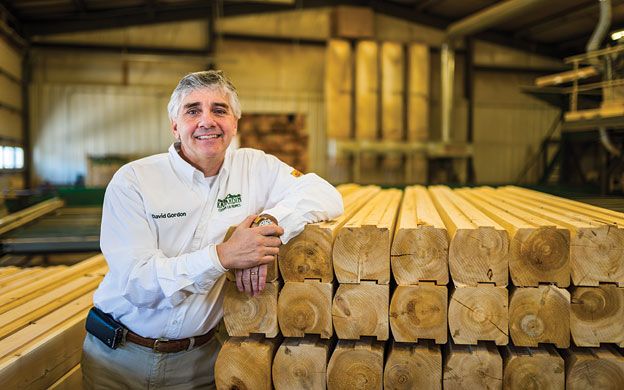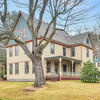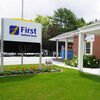Post-recession sales surge for log home makers
If diversity has been key to surviving the recent recession for many in the construction industry, log home maker Katahdin Cedar Log Homes in Oakfield offers a compelling case in point.
“When we started in the 1970s, most of our business was fencing,” says David Gordon, owner. “We gradually shifted until it was almost all log homes. Then the recession came, and it was a good thing we sold fencing.”
Like many players in the new home market, Katahdin saw the demand for its log homes take a nosedive during the recession, weathering the downturn by relying on sales from its fencing division. Now Gordon is seeing interest in log homes rise again, to the point that the company recently bought a defunct sawmill in Ashland to provide more capacity, along with its two mills already operating in Oakfield. Today, business is about evenly split between building new homes and producing fences, says Gordon.
Not all log home makers have had similar success. Although a popular alternative for new homebuyers for the better part of a century, and despite easy proximity to the long, straight timbers that typically make up a contemporary log home, Maine's industry has taken it on the chin.
“The industry is a shadow of its former self,” says Jonathan French, dealer coordinator at Moosehead Cedar Log Homes in Greenville.
But 2013 was a better year than those before, and 2014 is showing signs of a real revival.
“There's a lot more activity than we've seen for a number of years,” says Jeannie Haggett, sales coordinator for Northeastern Log Homes in Kenduskeag. “Of course we're just getting started for the season, but we're definitely more optimistic.”
Down but not out
The statistics from the housing bust make for a sobering read. Even at companies that survived, sales as measured by the number of log home kits sold were down as much as 75% from their 2006 peaks. After the 2008 financial crash, Dostie's Log Homes in Augusta, Northern Log Homes in Bangor and Moose Creek Log Homes in Turner all closed their doors.
Even L.C. Andrews of Windham, the second-oldest maker of log homes in Maine, in business since 1926, is closed this winter, though the company's website says it plans to reopen March 1.
The surviving manufacturers, according to Dan Crowley, executive director of the Maine Wood Products Association in Belfast, are “a lot more flexible, and have much stronger business plans” than the days when there were dozens of new entries in the field. The association, which has several log home manufacturers on its rolls, lost nearly half its members since the onset of the recession, Crowley says.
Maine is currently benefiting from the “reshoring” of manufacturing from China and other low-cost producers as companies become better positioned in the “higher-margin, lower-volume” market, Crowley says. Home building, in particular, has become a highly customized market — an observation that the manufacturers confirmed.
“Probably 95% of our packages have some custom elements,” says Gordon of Katahdin Cedar Log Homes.
Smart manufacturing
While the demand for log homes seems to be on the uptick, none of the manufacturers are resting easy. Competition means it's important to get maximum value out of each log, says Gordon. In Katahdin's case, the largest timbers go into the log home packages, while smaller ones are used for fencing. After those cuts are made, the sawyers make even smaller pieces for planters and bird houses — and the sawdust and chips go into Katahdin's biomass boilers.
“We use about 99% of every log that comes in here,” Gordon says.
At Maine Pine Log Homes, a subsidiary of Hammond Lumber's Belgrade mill, a parallel strategy is based on dividing white pine logs from dimensional lumber.
“We get maybe two or three logs from the core of each pine log,” says Paul Violette, the division manager. “The rest goes into boards of various shapes and sizes.”
Hammond has been selling log home kits since 1987, but Violette had never seen anything like the fall in demand after 2008, when sales sank to as few as half a dozen units annually.
“If that's all we were selling, we would have been in a world of hurt,” he says. After an initial slump, the lumber business, by contrast, has been strong.
As for log homes, based on initial inquiries this winter, “it looks like they're coming back,” he says. It helps that Hammond offers everything from basic homes to high-end models.
While there are still buyers for one-room hunting camps and vacation getaways — kits can be found for as little as $10,000 — most of the markets have gravitated toward larger second homes where packages sell for up to $250,000. Some custom log home kits have sold for as much as $350,000.
Changing technology, markets
The first logs homes in Maine — as opposed to log cabins, which were built by the early European settlers onward — are usually dated to 1923, when Bruce Ward of Houlton decided to use some surplus northern white cedar logs he had cut for utility poles to build a lakeside cabin. He soon perfected a system of interlocking pieces that were a far cry from the drafty settler cabins of yore.
Log homes are manufactured to fit together tightly, without air leaks, and initially relied on splines and caulking to produce a tight seal. Ward Cedar Log Homes is still in Houlton 90 years later, but there have been many refinements, according to Ron Silliboy, head of corporate sales. The gasketing system that now goes between the logs was introduced in the 1990s, and logs can now be produced with fewer defects and less checking and cracking.
Log homes were a hit with the back-to-the-land generation of the 1970s, and sales boomed. Still, says Silliboy, by one estimate there will be 1 million housing starts nationally in 2014, with only 25,000 likely to be log homes. In Maine, the market is a little larger, says Gordon — about 2% to 3% of the projected housing starts will likely be log homes.
Still, that's not a lot of units, so Maine companies are trying to spread their nets wider. While shipping costs make logs homes less competitive in the national market — most Maine-manufactured log homes are built in New England and upstate New York — they have also been built half a world away.
Gordon still marvels over a project in which Katahdin ultimately built a lodge and several homes in Chengdu, the capital of Sichuan province in Southwest China. Representatives of a real estate firm in China visited several Maine manufacturers in 2011 and chose Katahdin for the lodge. They then flew Gordon and other Katahdin representatives to China “and gave us the red carpet treatment,” he says. Several homes were sent abroad in 2012, and made up 30% of the company's annual revenue in an off-year.
The log structures were built around a lake, and were marketed as an American-style resort.
“All the furniture, everything, was imported from here,” Gordon says.
While not typical, these opportunities are not unique. Jeannie Haggett at Northeastern says the company has sold homes in the Virgin Islands, Russia and Israel. A buyer in Japan provided a testimonial after an earthquake leveled most of the housing in his area but left his log home intact.
Most manufacturers have extensive dealer networks to market as widely as possible; Gordon says Katahdin recently picked up its first dealer in Bulgaria.
New buyers
While log homes were well-adapted to the market of the 1970s, with its emphasis on rural charm and simplicity, trying to figure out what today's buyers want is challenging. Along with the need for custom features — made easier by computerized design and milling equipment — there's the basic question of what a log home should look like.
At Katahdin, Gordon has decided that hybrid models may be a big part of the company's future, coming out with an Arborwall model line that, from the inside “may not look very much like a log home at all.”
The designs borrow timber-frame elements, such as trusses, and provide larger windows, a variety of wall coverings and a strong contemporary feel, he says. They're suitable for a more urban setting than the rural and suburban lots that are more typical sites for log homes.
Another need for innovation has come from increasing demand for energy efficiency by many upscale buyers. While the solid logs — 6 inches for cedar, 8 inches for pine — performed much better than houses built before the 1970s, they fall below the R values now sought in contemporary homes.
Katahdin now offers insulation packages that add solid foam to the inside of the log walls, with cedar paneling added to mimic the original log surface — or, in other cases, Sheetrock or another non-wood finish. These hybrid walls are just as efficient as the highest-rated stick-built models, Gordon says, and are used in many units the company has sold in the past five years.
Other manufacturers rely more on the traditional logs. Jonathan French at Moosehead says that logs perform better than a comparable R value in fiberglass or foam insulation because of the greater thermal mass they represent. For those who like logs, the same look inside and out is still valued.
Another distinction in the Maine industry — white cedar vs. white pine — may be more a matter of taste than value.
“The cedar mills claim that their wood lasts longer than pine, is more resistant to rot and stands up to moisture,” says Paul Violette. “The truth is that, on a modern foundation, separated from the elements, they both work fine.”
While both pine and cedar need a coat of wood preservative on the exterior, “They'll both basically last forever,” he says.
French, who was an owner at Northeastern's pine mill before moving to Moosehead, a cedar manufacturer, six months ago, agrees.
“It's mostly a matter of taste,” he says. “It comes down to which one you think looks better.”
While tastes in the new housing market may vary, there are some fundamental advantages to Maine log home makers. The supply of white pine logs in the state is enormous, representing 5% of all the trees growing in Maine. And while white cedar seemed scarce for a time — for the century following 1850 it was used for everything from utility poles to canoes — wood volumes have increased ever since then.
“We have no shortage of cedar in Maine,” Gordon says. “It's truly abundant.”
That could be a significant advantage against foreign competitors, especially from countries where deforestation continues apace. Gordon says he sees a future where log homes are valued even more highly than they are today. “It's a good reason for us to be here, and it will be a good reason to remain here,” he says.
Douglas Rooks, a writer based in West Gardiner, can be reached at editorial@mainebiz.biz.












Comments